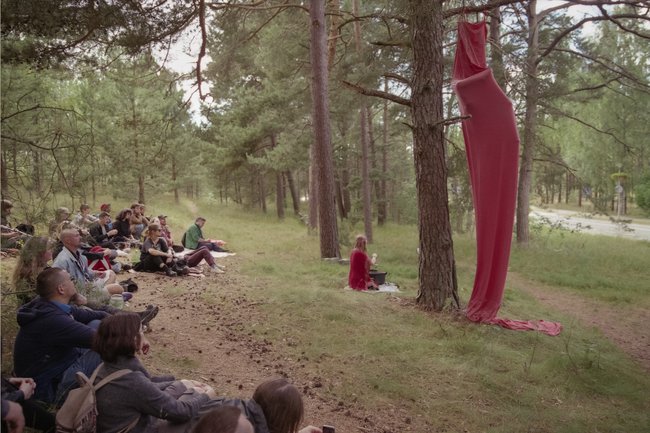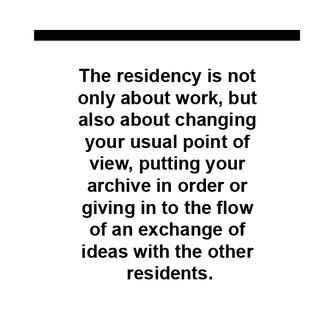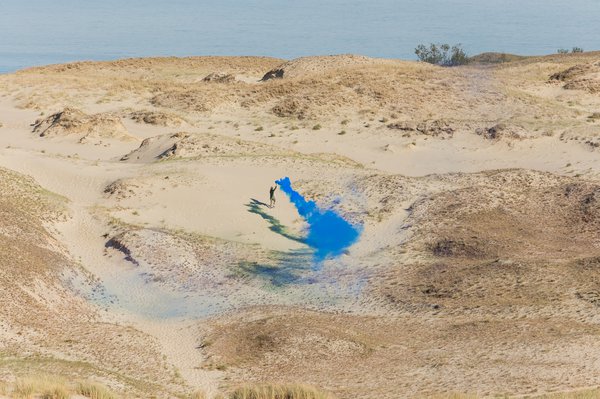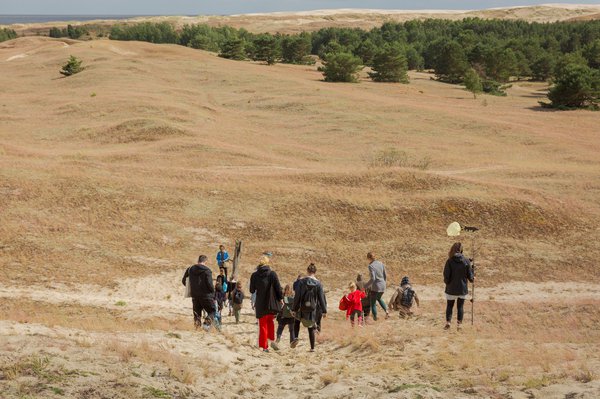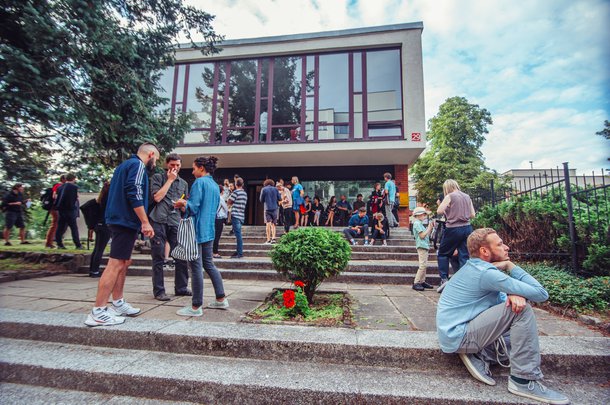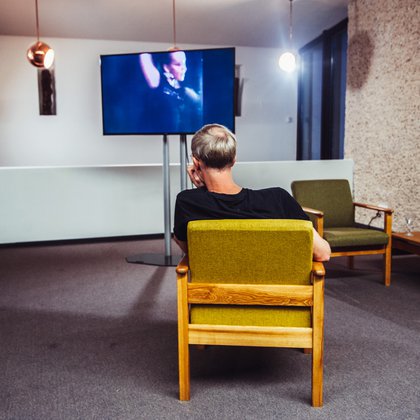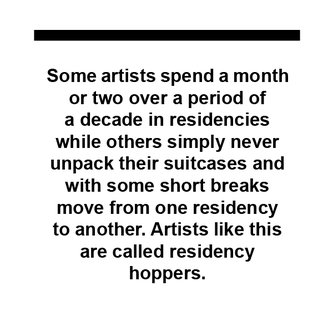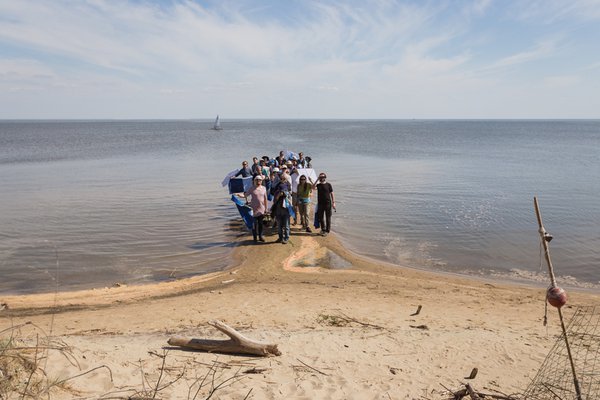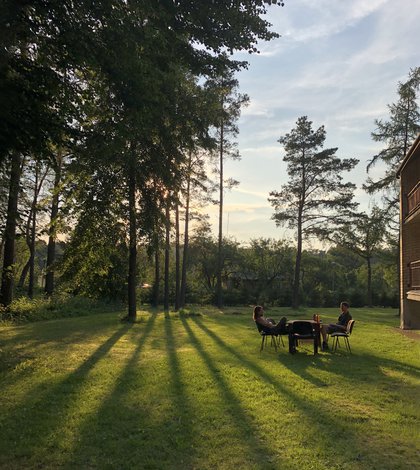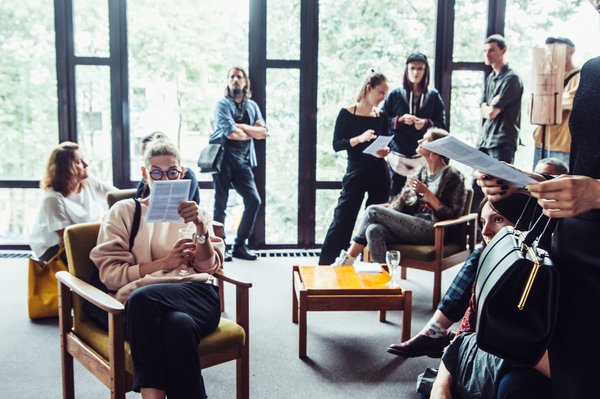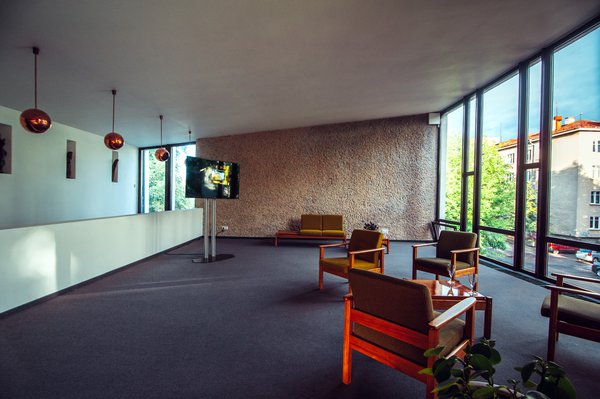Vytautas MICHELKEVIČIUS | Residencies as a Communal Mode of Interdisciplinary Artists’ Life and Existence
What are artist-in-residency programmes for? Accommodation or special service for artists, a valuable experience, trauma or disattachment form everyday life? Does the experience of residencies remind one more of a work or holiday regime? Is a residency a shared or individual experience? How does a residency programme look in the whole ecosystem of creativity? Is a specific place still important to a residency?
I can still remember my first residency Frise Künstlerhaus in Altona, one of Hamburg’s neighbourhoods. Then in 2005, when I was a young artist, I got the keys to the studio where I was housed, the organizers took me to some opening and I was then left to my fate (or to my own devices). I only met them again when I installed a show at their gallery at the end of the residency. I remember how happy I was on receiving an invitation to the residency organized by the cultural manager Rita Valiukonytė, and now after delving into the internet archives of my memory I remembered that my show was a part of a wider cycle of Lithuanian cultural events initiated by her in which the writer Jurga Ivanauskaitė and the photographer Romualdas Požerskis participated, the band Skamp played, and readings of the work of Jurgis Kunčinas and Ričardas Gavelis were given. Not a bad interdisciplinary context, was it?
Thirteen years later and after more than 20 visits and longer stays at other residencies I can confess that my first artist-in-residency experience was traumatic.[1] In spite of that, it was also productive since I created new work and put on a solo show at the end of the residency. I’ve heard similar stories from more than one artist when time spent at a residency at that time was perceived as a not very pleasant experience but later it seemed as very productive. For example, one German artist told me about 2 months spent in a residency in an Icelandic fjord in winter at which over that whole time she didn’t even see the sun, even though it did rise but the fjord blocked it off. She spoke about that period as torture, but, after it was all over, she was happy about the works and texts she created.Residency hoppers and newbies
If it’s a person’s first time in a residency it’s understandable that it might be hard to break the ice. I’ll try to come up with some experiences that might be similar to that of a residency. Think of any festival you’ve been to and you were living in another town or country for at least a week or longer. An intensive cultural programme, a lot of artists you’ve never heard of or seen before, a lot of incomprehensible languages or hard-to-understand English dialects, a lot of new acquaintanceships, but only a few with any depth, discussions to the early hours of the morning, long nights, a disruption to your normal schedule and biorhythms – no work, no home, no family-related matters to deal with, home sickness and missing your own work space eventually kicking in, an oversufficiency or insufficiency of creative tools, as well as an uncontrollable dynamic of ideas. A residency would be a similar experience but one that would last 4, 10 or 50 times longer. But only if it were to take place in a large artist-in-residency centre or in a metropolis. If it were to be spent in a small residency programme or a mid-sized or even smaller town, then it could be compared with some qualifications to either an excursion to a resort town or a farmstead, but in each case with its own specific nuances. That’s why it is necessary to know in advance an artist’s priorities and abilities to fit into different environments. Because to urban artists a longer period of time spent in the countryside or a small town (quite different to the resort town of Druskininkai or Nida) can become torture not only for them but also to the other residents and the people working at the residency.
One could describe the experience of a residency as being similar to that of a trip abroad in a camper van but one parked in the same spot for a longer period of time. Basically, the scenery and the space changes only once, but depending on the dynamics and its speed, the artists and the visiting guests at the residency change together with the residency programme. The residency also reminds me of a camper because you have to adapt to the new spaces and the level of comfort. It may seem that everything you need is there but something’s not right – things are not placed or installed in the usual place. Artists who need certain tools and equipment often say that the best residency is their own studio where they know where things are and how do they operate. But they’re not taking into account the other opportunities made available at a residency – it’s not only about work, but also about changing your usual point of view, putting your archive in order or giving in to the flow of an exchange of ideas with the other residents. The most important thing, when going there for the first time, is not to end up in a residency located in a small place (both in an urbanistic and architectural sense) where you’re given the keys, shown around the place you’ll be staying in and then said goodbye to. If you’re lucky you may receive another visit and asked how you’re getting on. An experience like that can only be successful if that was the artist’s aim: to close oneself off from other people in a hut in a forest and produce a new work. I can remember a residency on the island of Skomvær in the Lofoten archipelago (www.rostair.com), Norway, being able to serve precisely that purpose. It is located in a now defunct lighthouse and the only other thing on the island is nature. Food and other necessities are delivered to it about once a week by boat.Another example of a residency orientated in time and space in a radically different way is the DAAD Artists-in-Berlin residential programme which gives artists the opportunity to live and create in Berlin the whole year. The composer and artist Arturas Bumšteinas recently was a resident there. In this case it’s impossible to avoid relocating fully and integrating into the new local context. After residencies like these, there are some artists who permanently relocate to those towns while others return to their homes.
Some artists spend a month or two over a period of a decade in residencies while others simply never unpack their suitcases and with some short breaks move from one residency to another. In this way they always have a studio, accommodation, company and often a grant guaranteeing a source of subsistence. Artists like this are called residency hoppers. Sometimes this nickname is used with pride but at times with a critical and ironical undertone, especially from the perspective of artist-in-residency centres since in those situations they often feel like cows to be milked. On the other hand, if artists have participated in more than one residency, that increases their chance of being selected for another one, in particular if they’ve been in respectable programmes. The reason for that is that it’s much easier to work with artists who have experience of residencies than with newbies who may find it difficult to deal with lots of challenges: a new place, a new language and different culture, etc. For example, the organizers of the Estonian residency MoKS have said that they give preference to artists who have organizational experience since this residency is a village off the beaten track and if you want to live there comfortably you need to be quite self-supporting.
So, to sum up, a residency is a specific experience of time and space which is usually different from the everyday and helps to extend or compress the feeling of time qualitatively. One important aspect of residencies is the opportunity to experiment and attempt to deviate from one’s usual creative path and, of course, to create a new work. However, one shouldn’t forget the important function of a residency as a pause or ‘creative downtime’ when there is a retreat from the everyday and a ‘recharging’ in order to allow space for new ideas and works to come into being.
The importance of artist-in-residency in the ecosystem of art
Residencies can be dedicated to just one field of art or be multidisciplinary or cross-sector – accepting not just artists but also philosophers, doctors of medicine, lawyers, programmers and others who don’t want to work just in their own fields. However, there are also very specialized residencies (for example, EMS – the Electronic Music Studio in Stockholm) or ones in which the artists themselves choose to work on their own or collaborate with others. However, very few are able to avoid one very important element of residencies – collaborating with colleagues. Over breakfast, lunch, dinner, walks, sitting by the fireplace, at the table or over a drink. And this informal socializing between artists from different fields is one of the strong features of residencies. Not only is there an exchange in ideas but also in cultures, points of view, emotions, and arguments.
The residency as a way of creating art first emerged from the tradition of artists’ colonies in the second half of the 19th century, when with an increase in speed in the rhythm of life and the industrialization of cities, ever more artists began looking for a quieter and more creative environment and began organizing retreats mostly to the countryside or resorts. Only later did residencies become a part of an institutionalized and fully developed ecosystem of art. From that time on, residencies contributed to promoting the nomadic life of artists and the free movement of ideas and people.There are now thousands of residencies throughout the world. They’ve been taking place in the USA and Western Europe already for several decades, for example, one of the oldest and encompassing all fields of art is Banff Centre in Canada. Now celebrating its 85th year, it was founded in the national nature park with the same name and is known throughout the world as the leader in curated residencies.
So, some residencies are old and established, while others have just launched their activities. The hardest thing is to join the ranks of the established. For example, Akademie Schloss Solitude is one of the largest residencies in Europe, taking in artists and thinkers from various fields, but it’s quite difficult to get in – the artists have to be selected and invited by an expert panel – there are almost no open invitations. Among the Lithuanian artists who have taken part in this residency are the jazz experimenter Vladimir Tarasov, as well as the composers Lina Lapelytė, Ričardas Kabelis and Rytis Mažulis. It was there that the latter made the acquaintance of Alvin Lucier, the well-known American composer of experimental music and sound installations, who was able to give Mažulis a new creative impulse.It is often the case that an interdisciplinary artist’s CV is judged not by the amount and the prestige of concerts, performances, exhibitions but by the number of residencies and how well recognized they are. The more famous the residency and the more time spent there can be regarded as a serious creative step in an artist’s career.
The residency is a relatively new format in Eastern Europe but is gradually becoming an artist’s routine and to be found on his or her travel schedule – shifting from being a new fashion to a regular creative arrangement since residencies are capable of not only providing accommodation but also unique conditions for creativity. Of course, like every format it has its advantages and disadvantages and/or dictates its own conditions, allowing artists to achieve what they couldn’t at home because they have a special infrastructure: equipment, a professional team, and space.
Residencies are organized in various ways: some are regularly active self-governing institutions, others – temporary, thematic or working gatherings before festivals. It’s also the case that residencies can function as programmes of larger institutions (a university, academy, concert hall or art centre). For example, the Malmö Inter Arts Centre residency housed in a former chocolate factory is dedicated to collaboration between the different faculties and academies of Lund University: the visual arts, theatre and music. It’s not only students from different areas of study and professional artists who meet in this residency but also artists-residents from abroad who present their own creative work. In this way the residency provides an international exchange of ideas to a small town with a small cultural infrastructure, as well as becomes a platform for artists from various fields and different experiences to get together.Some residencies are managed by professional curators, producers and teams of technicians, others by the artists themselves. Everything depends on what the artist expects to get from them: whether its highly professional technical help or a less formal horizontal communication with the managers and organizers. Some residencies aim for specific results and creative production but there are those which focus on the process and its reflection. There are also residencies which develop long-term relations with artists, for example, by publishing their books, catalogues, scores or releasing their recordings. Akademie Schloss Solitude (located in a manor house near Stuttgart) has supported the collaborative creative work of the artists Lina Lapelytė, Rugilė Barzdžiukaitė and Vaiva Grainytė, that is, the contemporary opera Saulė ir Jūra (Sun and Sea) which is going to be presented in the Lithuanian Pavilion at Venice Art Biennale 2019.
Grants are also a very important part of the economy of residencies since some residencies provide them while others ask for part of the expenses connected with the residency to be covered, for example, the rent of the studio. Of course, the hardest is to get into programmes that give out grants – sometimes applications for one place are submitted not by a few dozen people but several hundred and then a residency becomes like a lottery. On the other hand, there is often also the other aspect of grants: if you get one, you have to work on an announced theme or provide some sort of service in exchange – for example, creative workshops to the local community. For this reason, many artists choose creative freedom and pay for the studio. However, it’s not so easy to get into residencies highly regarded by artists even by paying money – there are still competitions, and, besides that, you sometimes have to submit applications a year or even longer in advance.
Residencies in Lithuania and abroad: is a physical locality still important?
Even though the history of residencies began as a development of creative programmes connected to a specific place, in today’s age of global flow and migration we can also come across residencies without a specific location. It’s been more than a decade since centres and metropolises in the creative world have lost their power, and residencies that have been taking place successfully in peripheral countries or cities or in places off the beaten track is one of the good examples of that process.
Just like abroad, there are programmes in Lithuania with various aims and orientated towards various artists. There have been residencies operating successfully here for many years taking in interdisciplinary artists, most often located not in large towns or in their centres, among them are the Druskininkai artists’ residency DAR, Rupert in Valakampiai (on the edge of Vilnius), the Ars Communis Residency Centre YO-YO on the Žeimiai estate (in Jonava district) and the Nida Art Colony, affiliated to the Vilnius Academy of Arts, on the Curonian Spit. However, only the latter and Rupert operate all year round while the others are seasonal. The main problem with residencies that are located in remote places is how to reach a larger audience and present results, if, of course, that is among their aims since some residencies are designed specifically with the aim of ‘escape and retreat’ from audiences, producers and clients so that artists can create something new, to re-think their archives or simply have a deserved ‘creative break’. Remote residencies most often maintain communication with audiences through social media and various ways of documenting things or satellite locations – exhibition or concert halls in other towns. However, sometimes residencies become innovation incubators. For example, in 2015 during the 5th Inter-format Symposium at the Nida Art Colony and in the studio of the radio station Neringa FM there was a live broadcast-concert in three locations: Druskininkai, the Swiss Alps and Nida. The sound artists John Grzinich (EE/US) and Taavi Suisal (EE) mixed soundscapes in real time at the Druskininkai DAR residency on top of which a former Nida Art Colony resident, the artist and poet Gilles Furtwängler (CH), read his poetry live. A real audience was physically present at the Nida Art Colony symposium but all of the radio concert was also heard over the internet and in FM broadcasts and is now available as a podcast.Academie Schloss Solitude together with the ZKM Karlsruhe arts and media centre has for several years already been offering ‘internet residencies’ to which artists don’t have to come to physically. They apply to the residency over the internet and the participants chosen and given a grant work on their proposed projects from their homes or studios. Later, the results are presented during the residency network and a special portal webresidencies-solitude-zkm.com. So, the limitation of remote residencies can always be used as a specific advantage and in this way develop new ways of creativity and collaboration between artists and audiences.
Residency practices of Lithuanian composers
The young and middle generation of Lithuanian composers are quite active in attending various international residencies but those over 60 years old do not take part in this system and work on their compositions at home. Arturas Bumšteinas, Žibuoklė Martinaitytė, Lina Lapelytė, Rūta Vitkauskaitė and Šarūnas Nakas are amongst the most active residency practitioners, while Rytis Mažulis, Ričardas Kabelis, Vytautas Germanavičius, Raminta Šerkšnytė, Vytautas V. Jurgutis, Rita Mačiliūnaitė, Albertas Navickas have also accumulated various experiences of residencies.
Lithuanian composers view the experience, impact and benefit of residencies differently. For some of them it’s related to receiving money from various government foundations, an ‘unserious’ use of time, drinking wine and things thrown together in a rush whether it’s a ‘fragment’ of music or a peace symbol made up of pinecones imitating conceptual land art. Others are critical of so-called ‘residency hoppers’ as people who are simply parasites, travelling from one residency ‘greenhouse’ to another. However, a large number of Lithuanian composers who have participated in residencies view them positively as having a productive creative environment, providing positive results and meaningful professional acquaintanceships, and not as carefree holidays with expenses covered.
According to Lithuanian composers, residencies give them creative space, time and, depending on one’s choice, complete isolation or active communication and cooperation with other artists. Many of them emphasize the opportunity of being oneself in the context of their real profession, having escaped from the ‘squirrel wheel’ with its administrative tasks, supplementary activities, various projects, deadlines, family matters, and, finally, an uninteresting existence, such as walking to the bus stop or the everyday traffic jams. And even composers who only work as composers regard residencies as an opportunity for a contemporary artist to disengage from life, from being online, from an ever-faster lifestyle and to recharge one’s batteries for new creative projects. Some composers are happy to have got the chance to create in what are almost office hours, something they normally don’t do. Others enjoy breaking away from the 9 to 5 system which has become the societal norm and the imposed rhythm, and being given the chance to get to know their inner creative clock and to set up an individualized daily schedule. Some composers are affected not just by the practical but also the psychological aspects of residencies when they find themselves in an environment brimming with creativity in which thousands of artists have created previously, and for this reason work there seems to have taken on a natural speed and happen on its own.Many Lithuanian composers say that a residency is a particular kind of challenge: firstly, you have to prepare for it and then adapt to a new environment. If you want to create productively in a residency you must have not only clear creative aims but also the ability to organize your time effectively. Some authors confess that basically they feel a certain pressure to participate in the residency system and up their rating in this way because supposedly only the very best, the most active and the most open contemporary artists take part in international residency programmes.
Many of the Lithuanian composers participating in residencies think that they can simply go on creating music at home, which is something they all do, but working under home conditions requires a great deal of concentration and physical resources. In particular, if you’re not able to survive just from composing and aren’t a composer living comfortably on your own, over time that becomes an exhausting matter. In this respect, residencies provide a space to develop compositions for a longer period of time, more deeply, and under high-quality conditions.
Asta Pakarklytė
[1] On the subject of residencies, traumas and friendship I can recommend Viktor Misiano’s ‘What Resides in Your Trauma?’ (in the Nida Art Colony Log On Time http://nidacolony.lt/lt/741-7-kolonijos-zurnalas (PDF) or https://vimeo.com/130351657).
